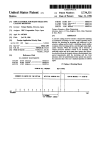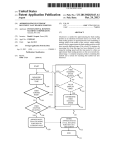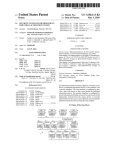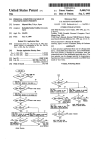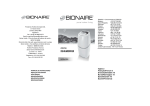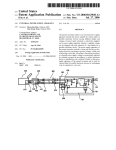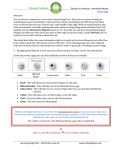Download Security switch
Transcript
USOO8924708B2 (12) United States Patent (10) Patent No.: Yoffe et al. (54) US 8,924,708 B2 (45) Date of Patent: SECURITY SWITCH (58) *Dec. 30, 2014 Field of Classi?cation Search CPC ....... .. G06F 21/30; G06F 21/55; G06F 21/70; (71) ApplicantszSimon Yoffe, Givat Shmuel (IL); David G061; 21/82 YOffe’ GM“ Shmuel (IL) USPC ........................................................ .. 713/152 (72) Inventors: Simon Yoffe, Givat Shmuel (IL); David see apphcanon ?le for complete search hlstory' Y ff G' t Shm 1 IL 0 6’ Iva ue ( ) (*) Notice: (56) References Cited Subject to any disclaimer, the term of this U S PATENT DOCUMENTS patent is extended or adjusted under 35 ' ' U-S-C- 154(b) by 0 days- 7,992,024 B2 This patent is subject to a tenninal dis_ 2011/0131639 A1 Clalmer- OTHER PUBLICATIONS (21) APP1~ NOJ 13/969-1748 Rabiul Islam, Anil Sabbavarapu, Rajesh Patel, Manish Kumar, Jeff _1 d (22) 8/2011 Islam etal. 6/2011 Buhler et al. Nguyen, Binta Patel, Amrish Kontu, “Next Generation Intel® F1 6 ' Ang' 19’ 2013 (65) ATOMTM Processor Based Ultra Low Power SoC for Handheld Prior Publication Data Applications”, IEEE Asian Solid-State Circuits Conference, Nov. 8-10, 2010, Beijing, China. US 2013/0340069 A1 Dec. 19, 2013 Related U_s_ Application Data Primary Examiner * Mohammad W Reza (63) Continuation-in-part of application No. 13/020,042, g4) fliotzqqugen? orlgrrgli Nathan&ASSOCIates patent ?led on Feb. 3, 201 1, now Pat. No. 8,522,309, whichis a continuation-in-part of application No. 11/741,751, ?led on Apr. 29, 2007, now Pat. No. 8,090,961. (60) Provisional application No. 60/881,510, ?led on Jan. 22 2007 ’ ' '3 (57) enac em a an ABSTRACT syStem and I-nethOd for seem-mg a perspnal deVICe that 1ncludes a deV1ce core and a peripheral deV1ce from unautho rized access or operation. The system comprises an isolated . (30) gen 5 . . . . switch, included fully or partially within an envelope of the Forelgn Apphcatlon Pnonty Data personal device. The isolated switch cannot be affected in its operation by either the device core or the peripheral device. Feb. 5, 2010 (51) (52) (RU) ................................ .. 201000159 The switch may be Operated by an authorized user of the P ersonal device either P reemP_tivel y or in _ res P onse to_ a Int. Cl. H04L 29/06 (2006 01) detected threat. In some embodlments, the 1solated sW1tch G06F 21/30 (201501) includes an isolated controller which can send one or more G06F 21/55 (201501) signals to the peripheral device and/or part of peripheral G0 6F 21/70 G0 6F 21/82 (201501) (2013'01) ' device. In some embodiments, the isolated switch includes an isolated internal component and an isolated external compo nent, both required to work together to trigger the isolated switch operation. In some embodiments, the isolated switch US“ Cl“ CPC ~~~~~~~~~~~~~~ ~~ G06F 21/30 (201301); G06F 21/55 (2013-01); G06F 21/70 (201301); G06F 21/82 includes an isolated disconnector for connecting and discon necting the device core from part of the peripheral device. (2013.01) USPC ........................................................ .. 713/152 20 Claims, 16 Drawing Sheets Personal Device 56 Device core 100 Isolated switch 102 lsolated User input 400 Logic User Input components Peripheral Device 1 04 402 US. Patent Dec. 30, 2014 Sheet 1 0f 16 US 8,924,708 B2 FIG. 1 Device core 100 , 7‘ Personal Device 50 V Isolated switch Peripheral Device 102 1 04 US. Patent Dec. 30, 2014 Sheet 2 0f 16 US 8,924,708 B2 FIG. 2 Device core 100 Personal Device 52 Isolated switch 102 i Isolated disconnector 200 t Peripheral Device 1 04 US. Patent Dec. 30, 2014 Sheet 3 0f 16 US 8,924,708 B2 FIG. 3 Personal Device 54 100 Device core T Isolated switch 102 swltCh MOde Indicator 300 4* Isolated disconnector 200 T l Peripheral Device 1 O4 US. Patent Dec. 30, 2014 US 8,924,708 B2 Sheet 4 of 16 FIG. 4 Personal Device 56 100 Device core Isolated switch 102 Isolated User Input 400 Logic l / User Input components Peripheral Device 104 402 US. Patent Dec. 30, 2014 Sheet 5 0f 16 US 8,924,708 B2 FIG. 5 Personal Device 58 1 00 Device core Isolated switch 1 02 200 Isolated disconnector 1105:“ user Input \ User components Input Peripheral Device 1 04 400 US. Patent Dec. 30, 2014 Sheet 6 0f 16 US 8,924,708 B2 FIG. 6 Personal Device 60 _ Dewce core /. R/ ‘1 ‘ I . ‘ // /I’ l’/ l/ 100 ,I .// // isolated switch 200 _ isolated dlswnneotor 400 1240le User Input Input Mode Logic ‘ Indicator l \ \_ \vl User Input components Peripheral Device 1 02 104 402 500 US. Patent Dec. 30, 2014 Sheet 7 0f 16 US 8,924,708 B2 FIG. 7 Personal Device 62 Device core 100 Isolated switch 102 200 Isolated disconnecth limited user Input og1c 400 communication components 602 Sensor corn onents p 600 user Inpm components 402 Peripheral Device 1 04 US. Patent Dec. 30, 2014 Sheet 8 of 16 US 8,924,708 B2 FIG. 8 Personal Device Device core 64 100 500 Isolated switch 102 Input Mode Indicator 300 200 SWItCh Mode 1501ate d disconnector IndlC?tOT Isoluted User Input Loglc 400 Communication components 602 Sensor components 600 User Input components 402 Perlpheral DeV1ce 1 04 US. Patent Dec. 30, 2014 Vd Sheet 10 0f 16 US 8,924,708 B2 Vd 1)— To clrumno be l1 To “Hummus Immune“ l1 KK I Keya lnmrupten LR2 KK . s m“: > - J33“: LED % LED thRI! :; 122 i m : F|G_ 10 FIG. 11 ii“. M 1 . \ Key5 E 3 T 0N5 5 T . 7 _ Reset Data 4-_ W ,__ ‘—L — Q Mn M a LZD" ° \— L1 lb . Tucimunstobe imelupied 94 O FL6 KeyA 0N4 Vd Clock R1 11 § 2 \_._._. _._._. .__ I 7 7 7 77 0°" \_ Ret Data - Q2 Key3 Vd 6 _ Q L F|_5 0N3 Clock '9 i T dip / km T 4? Reset Data - ' K2 2 amaln _| Keys —u\— 6 FL4 0N2 y L2 —’VV\/— “PM,” 9.“ 12 % 4 [ Q @W R2 2‘ m Coil Clock | ; g A; 1% Reset new I22 _ . “W1 Q 0N1 Vd Q FIG. 12 Clock i FLa US. Patent Dec. 30, 2014 Sheet 11 0f 16 US 8,924,708 B2 Security Sw'rtch _(____l.._-,----IQ---4%I\--_<____¢__¢_____§__+__ Mode1+2 Mode2 D1 _.____?__¢!>___?__4!-___ Mode1 _4;____¢__¢_>____'p--q!_\--- ""mflgm'“ Normal Mode Op?m Voc or Grd Y m H :[l Audiolmuflm _, 'D EH5 u — \—l —> . vnn Transoelver Camera Module 5) u I I ‘ i Opinn Camera IC - i V CPU DCZ Memory SIM Card Graphic LCD \ GPS Receiver Keypad EH5 EH}. V US. Patent 53 Dec. 30, 2014 Sheet 13 0f 16 100 102 700 104 FIG.15 US 8,924,708 B2 US. Patent Dec. 30, 2014 1‘55 Sheet 14 0f 16 174 173 172 PH1 FIG. 16 US 8,924,708 B2 US. Patent 175 Dec. 30, 2014 Sheet 15 0f 16 174173172 EH1 FIG. 17 US 8,924,708 B2 US. Patent Dec. 30, 2014 Sheet 16 0f 16 Figure 18 US 8,924,708 B2 US 8,924,708 B2 1 2 SECURITY SWITCH means such as phone-lines, cables, a wireless LAN, Blue CROSS REFERENCE TO RELATED APPLICATIONS munication means can be used to retrieve private information, tooth, etc, which only increases the security risk. These com audio/video information, user location information (track where user is located when personal device is using out com munication) or transmitted information, and can be used for transmitting data on the user’s behalf without his/her knowl This application is a Continuation in Part of US. patent application Ser. No. 13/020042, titled “Security Switch” and ?led Feb. 3, 2011 (now US. Pat. No. 8,522,309), which was a Continuation in Part of US. patent application Ser. No. edge. 11/741,751 titled “Security Switch” and ?led 29 Apr. 2007, which claimed priority from US. Provisional Patent Appli components such as a microphone, earphone(s), speakers, cation No. 60/881,510 ?led 22 Jan. 2007. This application further claims priority from Russian patent application No. location. Devices with permanently installed or accessory Devices with permanently installed or accessory sensor camera, etc, are able to capture the information at a user communication components such as a modem, a LAN 201000159 ?led 5 Feb. 2010, now allowed as EAPO patent adapter, a wireless LAN adapter, Bluetooth, GSM, etc, are No. 013885. All of the abovementioned patents and patent applications are incorporated herein by reference in their able to transmit information and may reveal the user location. When signals are transmitted from the user location, the transmission can be used for tracking the user location. Com entirety. ponents of a device/appliance that are controlled by software and electronic switching devices may be controlled by an TERMS 20 Authorized user4owner or permitted operator of a personal device. unauthorized user even if they were disabled earlier by the authorized user. The components can be controlled without the user noticing the change in mode of operation. For example, a mobile phone may look “switched off” but may Unauthorized useriany user or software that does not have still be functioning or even transmitting, making a call or an explicit permission to operate the personal device. Unauthorized acces siany attempt of an unauthorized user to 25 sending an SMS on the user’s behalf, or capturing private conversations around its location. access or operate a personal device Local authorized or unauthorized users can easily modify False indication/noti?cationian indication showing one state, while another “real” state is different. the software operating the personal device, thereby causing a security breach, e.g. by downloading a virus-affected soft Hooked componentia component connected in parallel with other device(s) to the same input element, in such way that both devices can operate together, but the hooked compo 30 common: on one hand it is much easier than hardware modi ?cation, and on the other hand it is much harder to verify such nent is isolated from the other device(s). “Man in the middle”ia component logically placed between a modi?cation, or notice unwanted change. At present, the problem of unauthorized access is handled two other components and which can control the informa tion passed between the two other components. Secure Inputian input readable only to a permitted compo 35 by different types of security software such as ?rewalls, anti virus programs, anti-spyware programs and security systems. However, each new software security system is eventually overcome by new hacking methods, viruses, worms, Trojans 40 between security providers and unauthorized users. In essence, software security is hard to implement and/or prove. Even if the theoretical model of the security is proven, there may still be a mistake or bug in the implementation that allows a break in the security. Consequently, software secu rity solutions cannot be trusted. Hardware security solutions are known and include: devices used to isolate telephone lines in order to prevent unauthorized capture of audio information from phone user (see US. Pat. No. 5,402,465 and US Pat. Application No. 20050271190); data line switches for computers that discon nect a computer line physically from the Internet, working in manual and/or automatic mode (US Pat. Application No. 20030062252); a power off method for a wireless peripheral device, which terminates power to all parts of the wireless device except the control chip by a certain operation on a connect button (US Pat. Application No. 20050009496); a switch that powers-on a PDA in response to the stylus being nent, meaning that the input of the permitted component cannot be revealed by others components. Internalienclosed within an envelope or surface of the per sonal device or positioned at least partially on the surface and other threats. This creates an endless competition of the envelope of the personal device. Extemaliseparate from a personal device but which can be connected to the personal device or plugged into the per sonal device. Isolated switchia switch that cannot be operated or affected by any entity or factor except an authorized user. 45 Independent operationian operation that cannot be affected by any entity or factor except an authorized user. Isolated controlleria controller that cannot be operated or affected by any entity or factor except an authorized user. 50 FIELD AND BACKGROUND Embodiments disclosed herein relate to the security of personal communication or computing devices which com municate with other devices which use software for opera 55 tion. Personal software operated devices or appliances (here inafter “personal devices”) such as mobile phones, removed from the PDA’s stylus holder and, selectably, pow ers-off the PDA in response to the stylus being replaced into IP-phones, pocket PCs, PDAs, laptop computers, desktop computers and network switches, use a variety of hardwired ware update. This scenario of software modi?cation is very 60 or wireless communication means for communication with other devices. A remote unauthorized user can adversely use these communication means to try and break open the per sonal device security and obtain personal and other informa the PDA (US. Pat. No. 6,233,464); a mobile phone with two input modes, whereby a switch of input modes is attained by changing an electrical connection between the main printed circuit board (PCB) in the phone and the front and back PCBs tion on the personal device user or owner, or to perform 65 (U .S. Pat. No. 7,031,758); the NetSafe Computer Security Switch, whichuses a simple physical switching technology in unauthorized operations on the user’s behalf. A single per a way that allows a computer or group of computers to quickly sonal device may have a number of different communication and easily block a communications signal from entering the US 8,924,708 B2 3 4 computer(s) and restart the signal without any software and trical, the security switch is isolated electrically, i.e. com pletely separated electrically from other elements or compo nents of the personal device. The principle of operation of the security switch disclosed herein relies solely on manual disconnection (or connection) of audio/video/communication or power supply components without the need to power down, reboot, or run software on the computer(s) (US Pat. Application No. 20040243825); a wireless button for a laptops, offered by the Hewlet Packard Corporation in its line of Pavilion laptops (hereinafter the “HP wireless button”), which enables or disables all inte in the personal device in order to avoid unauthorized access to grated wireless components in the laptop (e.g. WiFi and Blue the information or personal device. This provides full isola tooth), and a wireless light that indicates simultaneous the computer’s overall wireless state (enabled or disabled); the portable electronic device that disconnects a receiving antenna from the duplexer of a mobile phone (US Pat. Appli tion even in cases of full access to the device software or remote access to electronic components of the device, in the sense that an unauthorized user is not able to connect electri cal circuits that are switched off manually, and a bene?ciary side effect of power saving in case of power supply discon nection. Two main modes of operation are provided: “mode cation No. 20040203536A1). All existing protection solutions suffer from one of two disadvantages: either the switch is “external” and can there fore be tampered with by an external factor, or the switch is ”imanual switching by an authorized user (or simple “user”) for preventing capture of audio/video information from the user; “mode 2”imanual switching by the autho internal but not fully isolated from the device itself (and therefore can be manipulated by the software of the device). Consequently, existing solutions cannot provide simulta neous temporary protection from audio/video information 20 capture, cannot provide simultaneous temporary protection rized user for preventing unauthorized determination of the user location or capture of other information. In mode 1, the user can receive visual information (for example incoming from both audio/video information capture and unauthorized calls, SMS, memos, ?les, etc) yet is protected from being access and user location\device location and cannot provide listened to, recorded or visually captured by unauthorized secure security mode exit or prevent capture of the logic required for exiting the security mode. Existing internal 25 tion cannot be discovered by any means and no information switches cannot provide prevention of false noti?cation about the device security mode in a device with already broken transfer is possible. There is also a possibility to combine modes 1 and 2 into a “combined mode”. Note that mode 2 is software security, i.e. in a state in which an unauthorized user not a substitute for mode 1, since in case of unauthorized gains access or control of the personal device despite software 30 protection solutions. 35 SUMMARY 40 Embodiments disclosed herein disclose hardware security case of full access to the device software or by remote access 45 mation, user location information or transmission informa means, referred to as “security switch” or “isolated switch”, 50 means that the control elements of the switch do not have any external communication capability and are protected from remote operation/manipulation. In some embodiments a security switch disclosed herein is a component having (a) control elements that are not con nals, even in cases when the device security is already broken. The protection is based on an operation that can be performed only by an authorized user (manual disconnection of the relevant components) and that cannot be performed by the 60 control elements in (a). The security switch may be mechanical (i.e. electrical con software of the device or by the device itself. The protection is further based on the principle that the operation is not known to the software of the device or to the device itself. In some embodiments, there is disclosed a system for securing a personal device that includes a device core and a peripheral device from unauthorized access or operation, the tacts switched mechanically) or electronic/electrical. When mechanical, its control is already isolated because it can be operated only by manual physical operation of the user, not by connected, information cannot be obtained by an unautho rized user. When all components capable of transmitting a signal from or to a user’s device or appliance (i.e. RF, WiFi, Bluetooth, NFC, and LAN) are disconnected, the user loca tion and other private information cannot be obtained by an unauthorized user. Embodiments of systems and methods disclosed herein are not concerned with software security, but devices capable of capturing information or transmitting sig 55 be isolated and shielded, or that are decoupled in such a way the device itself. A mechanically operated switch should not have an electrically operated bypass. When electronic/elec capable of capturing audio/video informationiie. micro phone(s), headphone(s), speaker(s), and camera(s) are dis with protecting certain private information by disabling nected electrically to an environment from which they should that both electrical and magnetic ?elds cannot in?uence their operation, and (b) switching elements that cannot be con nected, disconnected or bypassed by elements other than the to disconnect components that can capture audio/video and user input information or transmit signals from/to the user’s personal device. When an electrical circuit is broken manu ally, it cannot be reconnected by an unauthorized user even in to an electronic personal device. When all components tion and for performing operations securely. The hardware are internal to the personal device and is isolated, both “inter nal” and “isolated” being de?ned above. The “isolation” also rarily change the mode of operation when in need of privacy and wants to avoid possibility of spying after him/her by capturing his/her audio/video information or tracking his location. A manually operated security switch allows the user tages. solutions that overcome the problems of hardware and soft ware security solutions mentioned above. They provide a user of a personal device with hardware means for protecting information such as private information, audio/video infor access; audio/video information canbe captured and stored in the device memory, then transmitted after the user exits mode 2. The switch allows the user of a personal device to tempo There is therefore a widely recognized need for, and it would be highly advantageous to have a simple internally isolated hardware security solution for the users of the above mentioned personal devices that does not suffer from the above mentioned software and hardware solution disadvan access to his personal device. In mode 2, the communication to the device is completely disconnected, so the device loca 65 personal device having an envelope or surface, the system comprising an internal isolated switch having operating func tions that cannot be affected by either the personal device core US 8,924,708 B2 5 6 or by a peripheral device, wherein the isolated switch includes an internal component located within the envelope or at least partially on the surface of the personal device and wherein the isolated switch internal component is selected FIG. 5 shows yet another embodiment of a personal device with a security switch disclosed herein; from the group consisting of a mechanical element without an FIG. 7 shows yet another embodiment of a personal device with a security switch disclosed herein; FIG. 8 shows yet another embodiment of a personal device with a security switch disclosed herein; FIG. 9 shows an example of an electro-mechanical imple mentation of an isolated switch disclosed herein; FIG. 10 shows an example of an electrical implementation of an isolated switch disclosed herein; FIG. 11 shows another example of an electrical implemen tation of an isolated switch disclosed herein; FIG. 6 shows an embodiment of a personal device with an input solution for security switch disclosed herein; electrically operated bypass and an electronic/electrical ele ment separated electrically from elements or components of the personal device. In some embodiments, the isolated switch includes an iso lated disconnector for connecting and disconnecting the device core from part of the peripheral device. In some embodiments, the isolated switch includes an isolated inter nal component and an isolated external component, wherein the isolated internal and external components trigger together the isolated switch operation. FIG. 12 shows an example of an electrical/ electronic 20 implementation of an isolated switch disclosed herein; FIG. 13 shows an example of an electro-mechanical imple mentation of an isolated switch disclosed herein; FIG. 14 shows an example of an electro-mechanical imple mentation of isolated switch disclosed herein; FIG. 15 shows yet another embodiment of a personal device with a security switch disclosed herein; FIG. 16 shows an example of electrical/electronic imple mentation of an isolated switch with partial disconnection 25 disclosed herein; In some embodiments, the peripheral device may be a sensor device, for example a microphone, earphone(s), speakers, camera, etc. In some embodiments, the peripheral device may be a communication device for example a modem, LAN adapter, Wireless LAN adapter, Bluetooth device, GSM device, RF device, etc. In some embodiments, the peripheral device may be a user input device for example a keyboard, touch screen, etc. In some embodiments, the peripheral device may be a USB device, for example a USB “key” or mass storage device (MSD), a USB Bluetooth device, a USB wireless device or any other known USB device. In some embodiments, the peripheral device may be a non-USB MSD, a display, a memory, etc. In some embodiments there is provided a method for secur ing a personal device that includes a device core and a periph FIG. 17 shows an example of electrical/electronic imple mentation of an isolated switch with isolated controller dis closed herein; FIG. 18 shows an example of electrical/electronic imple 30 mentation of an isolated switch with external and internal components for mutual triggering of operation disclosed herein. eral device from unauthorized access or operation, compris ing the steps of providing an internal isolated switch having operating functions that cannot be affected by either the per sonal device core or the peripheral device, wherein the iso lated switch includes an internal component located within the envelope or at least partially on the surface of the personal DETAILED DESCRIPTION 35 device, wherein the isolated switch internal component is selected from the group consisting of a mechanical element without an electrically operated bypass and an electronic/ electrical element separated electrically from elements or components of the personal device, and wherein the isolated 40 The invention discloses security systems and devices for protecting personal devices and their users from unauthorized access, operation, identity theft or information theft. In par ticular, the invention discloses a security switch that provides total protection of information related to the personal device or a user of the device. In the following description, like elements appearing in different ?gures are numbered identi cally. switch is con?gured to act as man in the middle between the FIG. 1 shows a ?rst embodiment 50 of a personal device device core and the peripheral device, and using the isolated switch to protect the device from unauthorized use or access. 45 with a security switch disclosed herein. Personal device 50 includes a device core 100, an isolated switch 102 and at least BRIEF DESCRIPTION OF THE DRAWINGS one peripheral device 104. The dotted arrows indicate an Reference will be made in detail to preferred embodiments disclosed herein, examples of which may be illustrated in the accompanying ?gures. The ?gures are intended to be illus 50 optional direct connection between device core 100 and peripheral device 104 and/or between device core 100 and isolated switch 102. Device core 100 operates by software and may include one or more controllers (e. g. central process trative, not limiting. Although the invention is generally ing units (CPUs)), one or more memory units and one or more described in the context of these preferred embodiments, it should be understood that it is not intended to limit the spirit and scope disclosed herein to these particular embodiments. The structure, operation, and advantages of the present pre ferred embodiment disclosed herein will become further power management modules. A peripheral device 104 may include one or more commu 55 nication components, and/ or one or more sensor components, and/or one or more user input components, and/or one or more other peripheral devices. Each of these will be shown in following ?gures. The communication components may apparent upon consideration of the following description, taken in conjunction with the accompanying ?gures, wherein: FIG. 1 shows a ?rst embodiment of a personal device with a security switch disclosed herein; FIG. 2 shows another embodiment of a personal device with a security switch disclosed herein; FIG. 3 shows yet another embodiment of a personal device with a security switch disclosed herein; FIG. 4 shows yet another embodiment of a personal device with a security switch disclosed herein; include wireless communication components or wired com 60 munication components (e. g. WiFi, RE, Bluetooth, NFC, LAN, and modem). The sensor components may include audio components, video components (e.g. a microphone, speaker or camera). The user input component may include a keyboard or a touch screen. The other peripheral devices may 65 include a USB or non-USB MSD, a display or a memory. In this and following embodiments and implementations, the peripheral device may be for example as USB device, i.e.




























